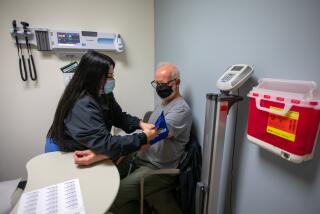Numbers Game Is Bad Medicine
- Share via
NEW YORK — Leigh was admitted to my hospital’s medical service with fever and severe lower abdominal pain. A CT scan of her belly revealed a large infection. All the internists caring for Leigh agreed she needed to have the infection surgically drained. But she was gravely ill. The hardest part of her care was finding a doctor willing to cut her open.
A few surgeons took one look at the size of Leigh’s infection and her weak condition, and recommended that she have it drained by a less-invasive procedure performed by an interventional radiologist. It was true, the less-invasive route was easier and posed fewer immediate risks to Leigh’s health. The surgeons worried that she would die from an operation as surely as from the infection. They didn’t want to take the chance.
But the less-invasive procedure wouldn’t get rid of all the pus in her belly. The internists caring for Leigh remained sure the risky surgery was her only hope. These are the medical battles played out every day in hospitals as doctors of different temperament and training approach similar problems with different resolve. So we called the hospital’s most daring surgeon. He agreed to operate. Leigh’s abscess was surgically drained. She recovered quickly and left the hospital two weeks later.
A surgeon’s decision to wield a scalpel is a subjective one. Some are eager to pursue the surgical fix. Others are more conservative and see it as a tool of last resort.
In California, two surgeons at a Redding hospital were recently accused of performing unnecessary heart operations in order to reap extra revenue. The California doctors might well be guilty of terrible abuses -- federal investigators are still examining documents seized recently in a raid of the doctors’ offices -- but the questions raised by the investigation are having consequences far beyond Redding. They are stoking a reexamination of surgery rates nationwide and sending a chill through surgical suites.
The same source that tracks health-care utilization rates and first brought attention to the Redding doctors -- the Dartmouth Atlas of Health Care in the United States -- has meantime found a host of disparities in care.
Medicare patients who live in Stockton, for example, are more than six times as likely to have coronary angioplasty as those in Buffalo, N.Y. Seniors living in Fort Myers, Fla., are four times as likely to have back surgery for disc disease as those residing in nearby Miami. Resection of the prostate for enlargement is performed in Columbus, Ga., at three times the rate it is in nearby Augusta.
But do these numbers really tell us much beyond that different doctors have different approaches? Do they really suggest that some doctors are being too quick to cut?
When surgeons display different propensities to use certain procedures, it’s rarely a symptom of malfeasance. Surgery is an inexact science, subject to a doctor’s judgment and daring and also to the desires of the patient. Still, discrepancies between one hospital’s surgery rates and another’s are increasingly being interpreted as possible indicators of abuse. This has become a primary way by which Medicare manages its costs.
Medicare flags physicians according to certain statistical yardsticks, such as the number of procedures they perform, and then launches a probe to sift through a possible offender’s records. While most doctors are cleared of these suspicions, the threat of the auditing process itself sends the desired message: Administer care sparingly or face a time-consuming and costly federal probe. The episode in California will probably be taken by the government as a vindication of its efforts and may well increase reliance on the practice.
The system is structured this way because Medicare is the primary watchdog. Health-care plans like Medicare and its member HMOs cite the wide range of practice variations to justify efforts to standardize care according to their medical cookbooks. Patients don’t always keep watch, since they are shielded from the cost of medical decisions and have little incentive to resist a procedure pitched as necessary, particularly if it is noninvasive and low risk. Patients are also effectively prevented from seeking out the best information since Medicare’s increased reliance on HMOs often makes second opinions costly and difficult.
Medical decisions -- and very likely, outcomes -- could be improved if insurers encouraged patients to participate in health care decisions and gain the knowledge they need to make informed choices. If doctors fully took patient preferences into account, there would still be practice variations. But the authors of the Dartmouth study argue that patient choices wouldn’t produce nearly as much variation among regions as do physician choices. So about the same percentage of informed patients would choose, say, breast-sparing surgery in Ogden, Utah, as anywhere else. In contrast, lumpectomies are now performed 15 times more often on Long Island than in Ogden.
In New York City, heart surgeons were ranked for a time by the state medical authorities according to the mortality rates of their patients. Where high-risk patients could have received open-heart surgery from dozens of top doctors a decade ago, there were suddenly fewer surgeons willing to take a chance on the most difficult cases. They didn’t want to rack up too many bad outcomes, lest they appear in the rankings to be poor surgeons -- and invite the ire of state medical investigators. New York righted the system by relying on risk-adjusted measures that took into account how sick the patients were to begin with.
In the absence of shared decision-making, the impetus to use raw measures such as surgery rates as red flags is destructive, a kind of arbitrary scrutiny that will make aggressive or high-volume surgeons an even rarer breed. These kinds of crude numbers give an incomplete picture, and will bring the same undesired backlash experienced in New York, making surgeons like the one who ultimately operated on Leigh more reluctant to take on the most difficult cases lest they run afoul of a yardstick.
Referring physicians like me, who often must spend hours calling around in order to find a surgeon willing to take on a tough case, aren’t well served well by the government’s heavy-handed tactics. Neither are our patients.






